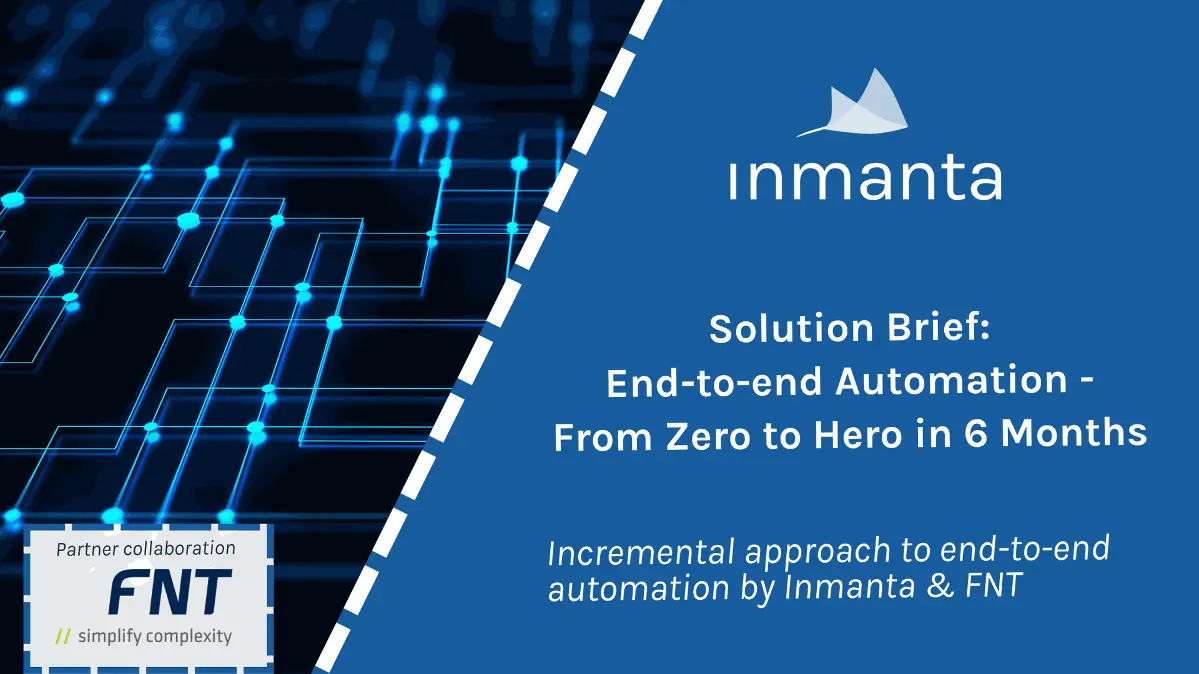Our major release 7.0 brings several exciting new features to Inmanta Service Orchestrator. The most important ones are:
- A new native ordering API enables you to send changes to multiple services.
- Resource discovery via our Active Adapters allows you to fetch the state of resources in your infrastructure without them being managed by the orchestrator.
- The service inventory now offers a graphical editor to create new services.
New ordering API
Inmanta Service Orchestrator 7.0 introduces a new native ordering API. For those familiar with TM Forum 641 or MEF Legato, this will look familiar. And our TMF 641 and MEF Legato implementations will now use this native API and its backend. Our API documentation explains how to use the new API endpoints. Version 7.1 (expected end of Q1) will release the view on this API in our Web Console to inspect the status of orders in a graphical manner.
Automatic resource discovery
Inmanta’s Active Adapters contain all the logic to interact with the APIs of your infrastructure. Before this release, adapters could only interact with resources managed by the orchestrator. In version 7 we added the ability to also discover resources that the orchestrator does not manage. The current focus has been on the adapter design and the backend. In version 7.1 discovered resources will also become available in the Web Console.
This is the start of an exciting journey with the end goal to make the onboarding of existing resources and services as simple as a click of a button.
Smart Service Composer
The Web Console now offers a graphical editor for service instances. This Smart Service Composer is a feature that has been in the making for a long time and is finally publicly available in version 7. Each service is represented as a box with its attributes, and services can be composed by drawing relations between them. If you want to start using our Smart Service Composer, you can enable it by adding instanceComposer to the features list of the Web Console. Photos below for example, creating a new mobile private network (MPN) with 5G data networks and slices. 

Improved usability of the service inventory
We have added a menu to each instance in the service inventory to make actions to these service instances directly accessible. No need any more to open the service instance each time, just open the menu and select the action. Actions for lifecycle transfers also became menu items. Additionally, we introduced a duplicate action that will open a new instance form with the same attributes.

Enhanced service modeling
The following updates focus on improving and simplifying the development and management of service models.
Simplified PIP configuration
Since module version 2, the Inmanta Service Orchestrator depends heavily on the Python package ecosystem. However, it was not always clear where each component in our ecosystem would fetch its Inmanta modules and Python packages from. Therefore, we overhauled this mechanism entirely in version 7. You can now configure a single source and the orchestrator will use this everywhere.
Introducing Float
The first versions of the language only had number as a numerical type. This type was both a float and an int. In earlier versions we already introduced an int type. Now we also introduced float and deprecated number. This type is now no longer used in std. In the next releases, we will continue migrating all our other modules and adapters.
10% performance improvement
We moved the Python version from 3.9 to 3.11. The RPM update will seamlessly update all virtual environments to use this updated version. This update makes sure that we can use the latest Python libraries and brings some nice performance improvements. For example, in many benchmarks we see a 10% reduction in compilation time for large models. Can you spot in our benchmark below when we switched?

Noteworthy updates
While the native ordering API, the automatic resource discovery in Active adapters and the Smart Service Composer steal the spotlight in our latest release, it’s essential not to overlook the significance of smaller noteworthy items. The upgrade to Pydantic version 2 may not be the biggest change, but the impact on enhancing validation and performance, particularly in API inputs, adds a valuable layer of efficiency to the orchestration process. Additionally, the Web Console now seamlessly links to the built-in OpenAPI docs and the service catalog, providing a straightforward path to service-specific OpenAPI docs. Even though these changes might not be headlining features, they are notable enhancements that contribute to a more refined and transparent orchestration experience.
Are you curious to see how these improvements can impact your orchestration experience? Request a demo and explore how end-to-end orchestration from Inmanta can help you streamline your network and service operations.

